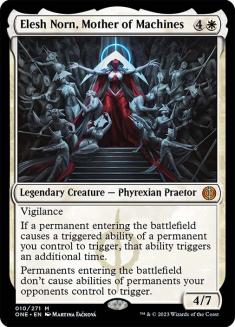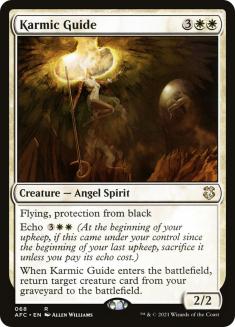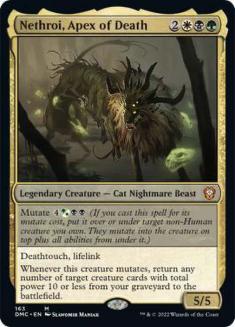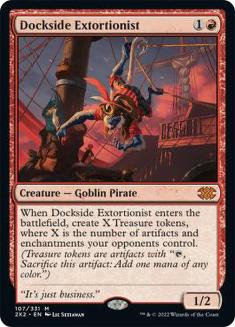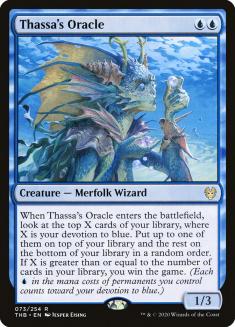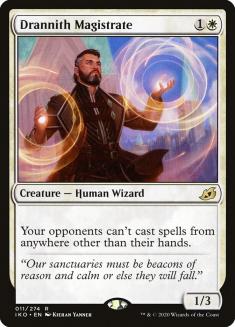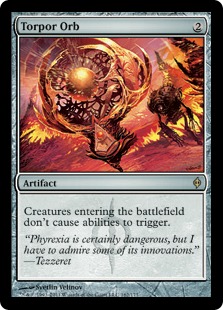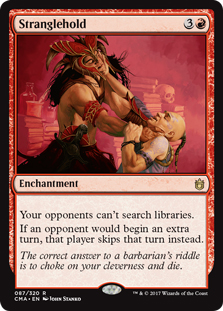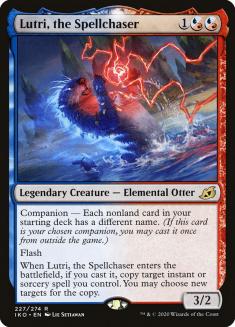The first Phyrexia: All Will Be One previews have hit the streets. Or more like slammed into the pavement. Normally at this point in the preview season, I’d take a quick first look at the few cards that were revealed. With due respect to Blue Sun’s Twilight; Jor Kadeen, First Goldwarden; Koth, Fire of Resistance; and Slobad, Iron Goblin, there’s only one card to focus on at the moment: Elesh Norn, Mother of Machines.
I have many words to say about this latest incarnation of the white Praetor. I suspect that my opinions might be polarizing in some regard. Even if you disagree with me on either side, I hope that I’ll be able to shape an argument that you can understand or at least make a point you see some value in. Cards can exist in a middle ground in which they’re some part good, some part not good.
Especially in Commander, we also have to remember that there’s more than just the mechanical value of cards. There’s also the (arguably more important) social value. Cards in Commander are more than just game pieces. They’re part of a vibrant ecosystem which includes well more than just game play. Elesh Norn, Mother of Machines is going to blow a wind of change through our landscape.
The Good
Flavor
This incarnation’s epithet, Mother of Machines, is reminiscent of a great song from Rush (my favorite band) called “The Body Electric.” Mother of All Machines is both prominent and significant in the lyrics. It’s a pleasant association that I’ll likely never be able to detach from the card. It has that going for it (although maybe it’ll eventually be a downside that I can’t get rid of the earworm).
The card’s art is something else. The main print is a stunning composition, with Elesh Norn the major source of color—in this case, the life-giving red of blood. The alternate versions are disturbing visions of what it means to be Phyrexian, all blades, and barbs, and angles. It’s not art that you sit back and enjoy. It’s art that sets its teeth into you and drags you along for the experience, which is intentionally and starkly uncomfortable—kind of what I imagine being compleated feels like.
Mechanics
Mechanically, the card is straight-up powerful. Despite there being lots of words, what it does is simple: doubles up our enters-the-battlefield triggers and denies those of our opponents. There are some situations in which that’ll help our opponents out, however, such as in the case of bouncelands like Orzhov Basilica, but for the most part it’s extra upside for us and doodly-squat for them. It’s a 4/7 with vigilance for the aggressively low cost of 4W.
Torpor Orb on steroids stapled to an also-juicing Panharmonicon is a going to treat you well if your primary motivation is winning. You’ll be shutting down opponents while accelerating yourself, a fine formula for getting into the W column. This version of Elesh Norn is destined to be a new piece in any kind of Staxy deck, and it will certainly get the job done. It’s hard to imagine a deck that wouldn’t get at least a little benefit from having it in the 99, even if that deck is only taking advantage of one side or the other.
The ability is also generic enough that we can explore lots of different themes with Elesh Norn, Mother of Machines, whether we’re using her as the commander, secret commander, or simply one of the 99. I don’t think I have a deck with white in it that she wouldn’t enhance. Just looking at my Halloween with Karador deck, she’d enhance Angel of Despair, Ashen Rider, Avenger of Zendikar, Bone Shredder, Duplicant, Eternal Witness, Karmic Guide, Massacre Wurm, Sister Hospitaller, Solemn Simulacrum, Sun Titan, Suture Priest, Verdant Sun’s Avatar, Wood Elves, and Woodfall Primus. That’s a pretty solid list.
As a rules side note, I’ll remind you that she doesn’t help out Nethroi, Apex of Death or other mutate creatures. By Rule 702.140c, successfully mutating creatures don’t enter the battlefield (if they fail to mutate they do, though), but merge with the target. I’d hardly call it a downside, and I doubt that little corner case will prevent anyone from playing the card.
Flexibility
Back to the original point, we can count it a positive that Elesh Norn, Mother of Machines (unlike with other legendary creatures, I somehow feel compelled to not shorten her name; only the full thing will do) doesn’t point us down a path towards a specific permanent type or subtype. All she really cares about are enters-the-battlefield triggers, and not just on creatures. A good Enchantress deck is going to have something like Eidolon of Blossoms or Nylea’s Colossus, which will trigger on other enchantments entering the battlefield. It’s also likely to have some enchantments that also draw cards when they enter the battlefield, like Abundant Growth.
Folks are also justifiably excited about Elesh Norn, Mother of Machines and landfall as well. Think of the lifegain with Courser of Kruphix or lifegain and card draw of Tatyova, Benthic Druid. Think of the extra counters with Avenger of Zendikar. I imagine that the landfall permutations are something you’ll see at your local tables pretty quickly after she hits the streets.
Then there are the triggered copiers, like Minion Reflector and Mirrorworks. Sure, we have to pay for them, but another two mana to get an extra copy of that creature or artifact is small potatoes. If we don’t want to have to pony up any extra mana, she’ll help us ramp up our Illusion count in one of my favorite cards from Jumpstart 2022, Preston, the Vanisher.
Shutting Down Problems
The other side of the coin is that Elesh Norn, Mother of Machines, shuts down two of the most talked-about and anxiety-inducing cards in the format, Thassa’s Oracle and Dockside Extortionist. I think turning off Dockside Extortionist might be more theoretical, since by the time we have the mana to cast Elesh Norn, Mother of Runes, everyone’s favorite Goblin Pirate has already done its damage.
It’s more likely to blank someone’s Thassa’s Oracle, since (in many cases), that’s a later-game play. The downside is that Elesh Norn, Mother of Machines is an on-battlefield trick. The Thassa’s Oracle player knows it’s there and isn’t going to just walk into it. Of course, preventing opponents from winning, even for a turn or two, might be the kind of delay window we need to execute our own nefarious plans.
It’s not just those two controversial cards, though. As I pointed out with one of my own decks, enters-the-battlefield triggers are extremely popular in Commander—and it’s not like designers are going to stop going to that well anytime soon. If you want to knock your opponents off something they’re likely to be doing a great deal of, accept no substitutes to Elesh Norn, Mother of Machines.
There are plenty of mechanical reasons to play Elesh Norn, Mother of Machines. It’s a very strong card and, if not under-costed, certainly priced at a steep discount. It will likely slot into any number of decks that you have already and make them better without any other changes.
It’s not all upside, though.
The Bad
Some of the same things that make Elesh Norn, Mother of Machines good also make it bad. Obviously, I don’t mean “bad” in the sense of it not carrying its weight mechanically, which I think we’ve clearly laid out that it has no problem doing. I mean “not necessarily good for the format,” in things like play patterns or deckbuilding. Or for future card design.
Before I dig in here, I’ll recognize that not every card is made for Commander or even with Commander in mind. I get it. I know that, given the larger story arc, an Elesh Norn card was going to get made. Needed to get made, in fact. It didn’t, however, need to be the card that got made.
Too Generically Good
As we on the Rules Committee (RC) have repeated with some frequency, we believe cards being generically good is a net negative for the format. While it can allow deckbuilders, as I mention above, to explore multiple different types of strategic or thematic lines, the flip side to being generically good means it introduces a sameness to many of our games.
The mechanical upside of being generically good is efficiency. That costs us in other ways. Once we get to the point of, “If you’re playing white, there’s no reason to avoid playing Elesh Norn, Mother of Machines” (or insert card name), we’ve reduced our effective deck size by one more card. When twenty or more of our cards have been decided before we actually start building the deck, we’ve headed in a dangerous direction. We’ve sacrificed creativity on the altar of efficiency. That’s good in formats which privilege the mechanical. It’s a contrarian position in Commander.
Too-Easy Value
Another good/bad point of this kind of generic goodness is that it enhances things that we’re already doing without having to make other changes. A card that just rewards you for playing Magic, for just doing the things you were already doing (I’m looking at you, Tatyova, Benthic Druid), is not healthy for Commander. Elesh Norn, Mother of Machines is the same kind of card. Our decks (and I really mean that collectively, not royally) have a high number of enters-the-battlefield triggers in them. At a very low cost—not just merely the very splashable 4W, but the opportunity cost of adding only a single card to the deck—we get major enhancement of what we were doing anyway. We have further devolution.
While I don’t want to spend too many evenings grinding out against Stax decks, I believe that there is some reasonable protection built into some cards that happen to be Stax pieces (like Drannith Magistrate; there’s also a thread on the RC Discord server on that one as well).
I’m okay with someone dropping Torpor Orb on me or eating my graveyard when I’m playing Karador. What’s problematic about Elesh Norn, Mother of Machines is the multiplicative nature of the two abilities stapled together. Asymmetry has to be very carefully managed. It can turn a card that’s a decent idea, like Stranglehold, into one that creates negative experiences instead of positive ones. I’ll point out again Elesh Norn, Mother of Machines’s relatively low mana cost of 4W. I’d be perfectly happy if it did only one of the two at that cost. For both, we’re pushing it by at least one mana, and if only one, then a white pip.
What the Rules Committee Members Said
We saw this card during design. Normally, we see the file, make our comments, and send them in jointly within a week or two. As soon as I saw the card, I sent off an email saying, “Please never print this card.” Shortly thereafter, I found out I wasn’t the only one of the four of us (this was before Olivia and Jim joined us) who had done that. We of course then talked about it together as well and reiterated our point during the joint feedback—this is not a healthy card for Commander.
This card does not look like it’s going to offer positive play experiences. It’s dangerously designed and then pushed mana-wise. I get that it’s a main-set card, not in Commander product, and I’ll return to the recognition that not everything has to be designed with Commander in mind. I’ll also point out that it would also be tremendously naïve for a designer/design team to ignore Commander’s existence when designing cards. Further, I have concerns that the design of this card getting through may impact the design of future cards.
The good news is that they can design whatever cards they need to, and we have remedies in place should things go awry—although to be clear, I’m not suggesting that they will, just that the possibility exists more strongly in this card than in others. And while I’ve offered some insight into how the RC operates or thinks strategically, I’ll point out that most of what I’ve said here is personal opinion. Certainly, any editorialization is mine and mine alone.
The Card’s Future in Commander
Please remember a few things regarding changes to Commander. First, we rarely do things right out of the gate; Lutri, the Spellchaser was an exception in exceptional circumstances.
Second, I’m one of six people who work together to make said changes. Even if I feel very strongly about the card, I would still have to convince the group to take action.
I’m firmly in the camp that the card is a net negative for the format, but that’s not the only part of the calculus. What remains to be seen—and observed over the next quarter or two—is if it is negative enough to take action on. If it demonstrates that it’s not having the impact that I caution it could, then we don’t have anything to worry about. I’ll say once again that it’s not what a card does; it’s what a card does to the format that’s important.
Always remember we have a channel on the Commander RC Discord server dedicated to discussing my articles. There’s a pretty good chance we break off a thread solely for discussion of Elesh Norn, Mother of Machines, since I think there’s plenty of conversation to be had about it. Then there are all the other great channels for chats about everything under the sun, moon, and stars. See you there!
Visit my Decklist Database to see my Signature Decks, the Chromatic Project, and more!


